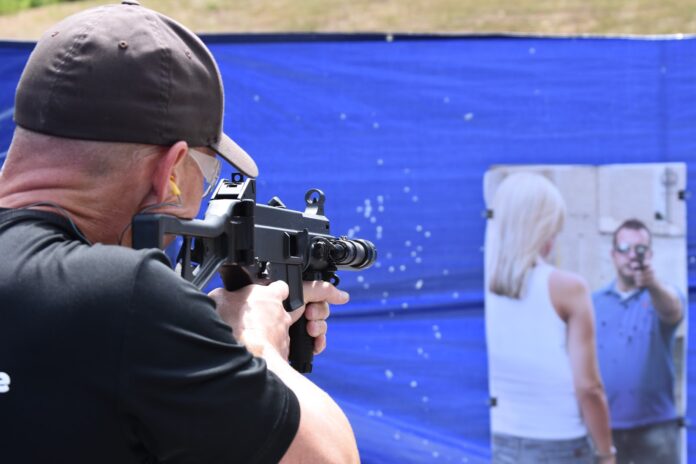
CULLMAN, Ala. – In 1999, two young men walked into Columbine High School in Colorado and began shooting students and teachers. The first officers to respond followed traditional training and waited outside for 30 minutes for SWAT teams to arrive, while the shooters had the building and student body to themselves.
In the last 21 years, that procedure has changed drastically. Law enforcement officers are now told to get into the fight as rapidly as possible, even if it means running into an active shooter situation alone. In a 2014 study of changing approaches, the Police Executive Research Forum stated the obvious: “A faster response is more dangerous to responding officers. Patrol officers who quickly move to confront an active shooter face a high likelihood of being shot themselves.”
This week, school resource deputies and Special Response Team (SRT) members from the Cullman County Sheriff’s Office (CCSO) are undergoing training in RAIDER response:
- Rapid deployment
- Awareness
- Intervention
- Decisiveness
- EMS
- Recovery
Chris and Julie Pattie operate the RAIDER Solo Engagement Training program.
On Thursday, Chris Pattie told The Tribune, “We’ve come to realize that not one (active shooter) incident has been solved by a multi-unit response, and we know that the first officer on the scene has to go in. We give this training to teach the officer how to use the infrastructure of the building, the way the mind and the body works and the movement to become their second person or, as we say, ‘protect your six.’
“If you’re going in by yourself, and you enter a room and turn left, and the bad guy’s to the right, you get shot in the back, is the fallacy that people have. But when you look at the science behind it, you realize that the time it takes to see something, process it, rise up and take a shot actually gives you time to make that turn and then turn around and take a shot before he can shoot you in the back.
“What we do is we start from the basics and we teach movements, and we teach them the proper movements to set them up in a way that they can enter a room without showing any part of their body. Once they make the entry into the room, the only thing a bad guy sees is their head and their gun. So, while they’re trying to process the officer coming in, it allows our officer the time to process the information and decide whether or not he needs to take a shot or keep moving, and then carry on with what he’s doing in clearing the room.
After class instruction, deputies faced off against each other in simulated active shooter scenarios at Good Hope Middle School with Airsoft guns, giving them the opportunity to put their newly-learned tactics into practice in situations as close to real world as possible while remaining safe. Wednesday and Thursday, deputies ran courses at the CCSO’s Dodge City firing range using live weapons, moving down hallways and into rooms, distinguishing between bad guys and bystanders and engaging their targets amid all the noise, smoke and smell of a real-world armed encounter.
Pattie noted, “We tell you how it works, we show you how it works, and then, through force-on-force training, we prove it to you that it works. Then you end up leaving with the mindset, the training and the ability to go into a structure when something happens and start dealing with the threat, and hopefully end the situation.”
The program has received positive feedback from the law enforcement community across the country, including multiple graduates who credit RAIDER with saving their lives in shootings.
While no graduate has yet had to respond to a school shooting, Pattie reported, “It was the mindset that the officer got after going through the program, the training they got, driving into a gunfight and being successful, it was that training- week-long tactics training- that set up the mindset that gave the ability that they felt that the armed encounter that they went into, this training’s what saved their life.”
According to Cullman County Sheriff Matt Gentry, the resource deputies who are taking the course this week are also being trained for certification as RAIDER instructors, so they will be able to equip the CCSO’s other deputies to respond to shooting emergencies in the same way.
Gentry told The Tribune, “The RAIDER course, for us, holds great value because, as deputy sheriffs, we’re spread out by ourselves throughout Cullman County. The course is designed to teach law enforcement how to handle situations by themselves tactically. This comes into great play for us at the sheriff’s office because of the distance between each other the deputies have to work. Our school resource deputies, since we have 11 in the schools, a lot of times they will be by themselves in a situation, if you have to deal with an active shooter and be the primary aggressor- as far as law enforcement go(es)- there, dealing with an active shooter at a school.
“The protection of our children is our most valuable resource that we have in the community, and we want to ensure that they have all the training necessary to be able to protect that valuable resource.”
Pattie said of the CCSO resource deputies, “These guys are hard chargers. They have worked extremely hard, especially with the heat. There was very little time that I turned around and saw them sitting around; they were constantly using the stuff that we set up back here to get better, and it shows. When they go through the ‘house,’ it shows.
“I’m dealing with guys that have a lot of experience and a lot of training, and some of these guys have a lot of tactical training. Usually that fights us, because this is a solo officer entry thing; it’s not a team tactic, and team tactics versus solo are completely different. When you get a tactical guy who’s been on a SWAT team for as long as he has, it’s hard for him to set aside his tactical training to learn the solo stuff, because some of the stuff we do in solo is completely against what you do in team. But the reason you do it is because you don’t have somebody- a number two- that’s going to watch your back, so now you have to utilize the infrastructure of the building, the movement and the normal reaction time of a human being to now be your number two person.
“These guys- I mean I’ve got some highly tactical trained guys that have set that stuff aside to really learn this program. They’ve taken off; they’ve excelled. It’s been a blast to teach these guys… the facility, the schools available to us to use. Quite honestly, I hope I come back.”
Copyright 2020 Humble Roots, LLC. All Rights Reserved.




























